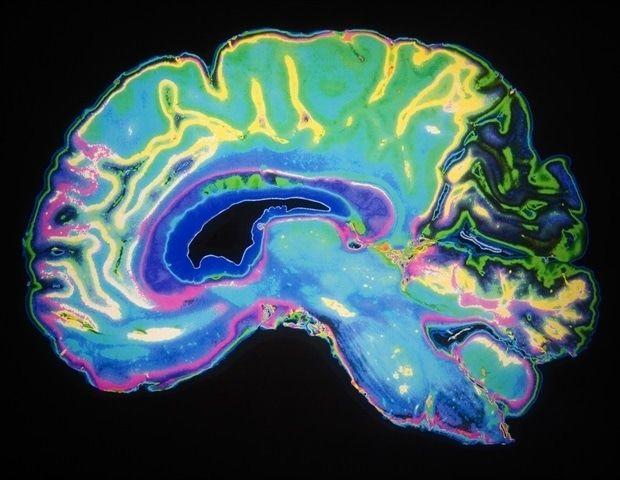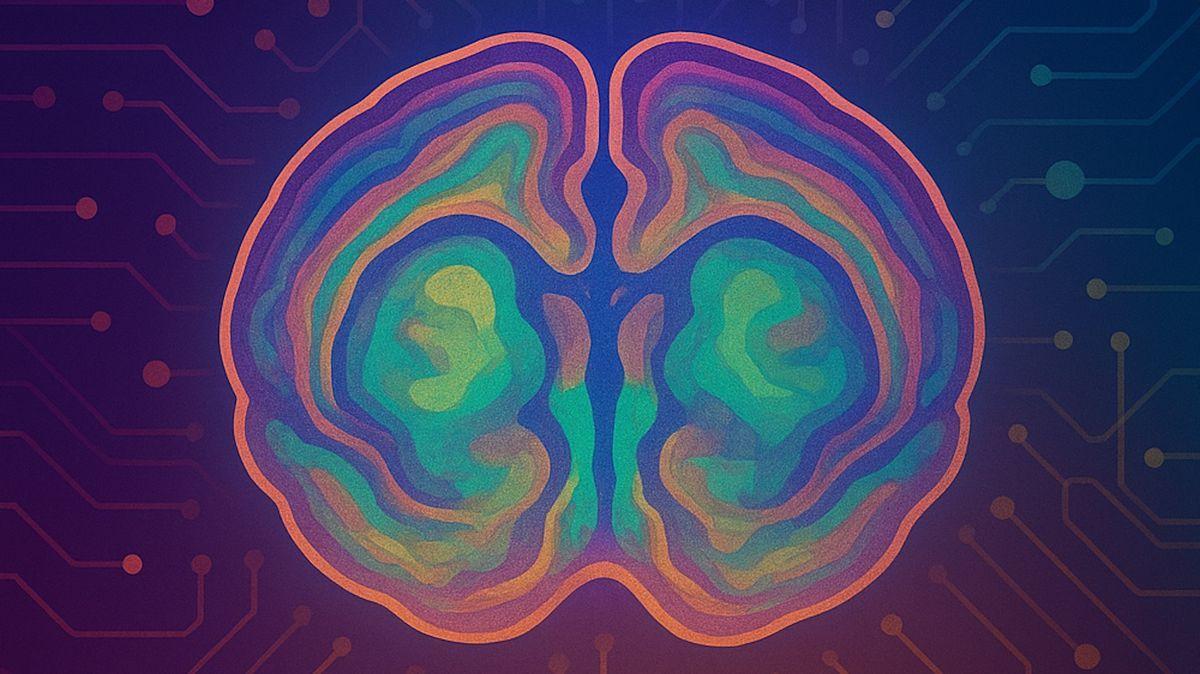AI-Powered Computer Model Maps Mouse Brain Blood Flow, Paving Way for Early Alzheimer's Detection
2 Sources
2 Sources
[1]
New computer model provides detailed look at mouse brain vasculature
Florida Atlantic UniversityAug 13 2025 Healthy brain function relies on a steady supply of blood. Disruptions in blood flow are linked to major neurological conditions like stroke, Alzheimer's disease (AD), and traumatic brain injuries. But understanding how the brain fine-tunes this flow - especially across its smallest blood vessels - remains a challenge. The brain's blood supply includes a vast network of vessels, ranging from large arteries to microscopic capillaries. Between these lie transitional zone (TZ) vessels - such as penetrating arterioles, precapillary arterioles, and capillary sphincters - that bridge the gap and may play a big role in regulating flow. But their exact contribution, particularly during increased brain activity, remains a subject of scientific debate. To explore these dynamics, researchers from the College of Engineering and Computer Science at Florida Atlantic University and the FAU Sensing Institute (I-SENSE) developed a highly detailed computer model of the mouse brain's vasculature, treating each vessel segment as a tiny, adjustable valve. The model simulates how brain blood vessels respond to two key factors: hemodynamics, the movement of blood through the vessels, and vasodynamics, the way vessels actively change shape in response to that flow. By integrating both processes, the model reveals how different components of the brain's vascular system work together to maintain stable blood flow - even as conditions shift, such as blood pressure fluctuation or increased activity in specific brain regions. To evaluate its accuracy, the researchers compared the model's predictions against real biological data. Results of the study, published in PLOS ONE, show that brain blood vessels operate in four distinct phases based on blood pressure. At very low pressures, blood flow drops below optimal levels. As pressure rises, the system enters a "sweet spot" where flow remains steady across a wide range. But beyond a certain threshold, vessels lose control and flow increases rapidly - potentially stressing or damaging delicate vessel walls. Not all vessels play equal roles in maintaining healthy circulation in the brain." Ramin Pashaie, PhD, Study Senior Author and Professor, Department of Electrical Engineering and Computer Science and Department of Biomedical Engineering, Florida Atlantic University Pashaie is also an I-SENSE faculty fellow. "Our model shows that transitional vessels - those between arteries and capillaries - make the most critical adjustments to protect the brain and ensure a consistent supply of oxygen and nutrients. It also helps explain how the brain stays protected across different physiological conditions. The vessel walls themselves - particularly the endothelial cells - can only constrict so much. Once that limit is reached, the system loses some control over blood flow, which can lead to increased stress on vessel walls and may contribute to disease or injury." The model also captured how blood flow increases during brain activity - known as functional hyperemia - with different types of vessels taking the lead depending on their location. In outer layers, sphincters and TZ vessels perform most of the regulatory work; deeper in the brain, penetrating arterioles take over. By accurately modeling how the brain manages blood pressure and oxygen delivery across its microvascular system, the team's work lays a foundation for developing better diagnostic tools, smarter simulations, and more effective treatments for a wide range of brain conditions. "As engineers, we're using computation to reveal what biology alone can't always show," said Pashaie. "Our model shows that healthy brains are equipped with fine-tuned systems for protecting themselves - but when those systems fail, even small changes in pressure or vessel function can have big consequences." The study underscores the power of cross-disciplinary collaboration between engineering, neuroscience and computational modeling. The team now hopes to refine the model further and eventually apply it to human brain data. This model is the most recent research phase in this FAU engineering team's pursuit of developing a procedure for early detection of AD through a simple eye exam. Based on experimental observations, the team has hypothesized that changes in the blood flow regulatory system of the brain occur at very early stages of AD, accompanied by ocular impairments. Similar changes in the blood flow regulatory system of retina are expected, which is accessible for imaging even in humans. By understanding how the blood flow regulatory system changes under AD and how these changes are correlated with the changes in retina, retinal vasculature can be imaged non-invasively. The imaging data can be processed by artificial intelligence algorithms to diagnose AD and classify the stage and progression of the disease. "This latest research provides novel and vital insights into the complex mechanisms that regulate blood flow in the brain - particularly how tiny vessels adapt to changing conditions to keep the brain nourished and protected," said Stella Batalama, Ph.D., dean of the FAU College of Engineering and Computer Science. "These findings don't just advance our understanding of basic physiology; they have real potential to transform how we approach neurological disorders as well as brain trauma. By combining advanced computer modeling with biological insight, our researchers are pushing the boundaries of what's possible in brain health." Florida Atlantic University Journal reference: Esfandi, H., et al. (2025). Depth-dependent contributions of various vascular zones to cerebral autoregulation and functional hyperemia: An in-silico analysis. Journal of Allergy and Clinical Immunology. doi.org/10.1371/journal.pone.0321053
[2]
Neural Navigation: FAU Engineers, Sensing Institute Map Brain's Blood Flow | Newswise
Newswise -- Healthy brain function relies on a steady supply of blood. Disruptions in blood flow are linked to major neurological conditions like stroke, Alzheimer's disease (AD), and traumatic brain injuries. But understanding how the brain fine-tunes this flow - especially across its smallest blood vessels - remains a challenge. The brain's blood supply includes a vast network of vessels, ranging from large arteries to microscopic capillaries. Between these lie transitional zone (TZ) vessels - such as penetrating arterioles, precapillary arterioles, and capillary sphincters - that bridge the gap and may play a big role in regulating flow. But their exact contribution, particularly during increased brain activity, remains a subject of scientific debate. To explore these dynamics, researchers from the College of Engineering and Computer Science at Florida Atlantic University and the FAU Sensing Institute (I-SENSE) developed a highly detailed computer model of the mouse brain's vasculature, treating each vessel segment as a tiny, adjustable valve. The model simulates how brain blood vessels respond to two key factors: hemodynamics, the movement of blood through the vessels, and vasodynamics, the way vessels actively change shape in response to that flow. By integrating both processes, the model reveals how different components of the brain's vascular system work together to maintain stable blood flow - even as conditions shift, such as blood pressure fluctuation or increased activity in specific brain regions. To evaluate its accuracy, the researchers compared the model's predictions against real biological data. Results of the study, published in PLOS ONE, show that brain blood vessels operate in four distinct phases based on blood pressure. At very low pressures, blood flow drops below optimal levels. As pressure rises, the system enters a "sweet spot" where flow remains steady across a wide range. But beyond a certain threshold, vessels lose control and flow increases rapidly - potentially stressing or damaging delicate vessel walls. "Not all vessels play equal roles in maintaining healthy circulation in the brain," said Ramin Pashaie, Ph.D., senior author, professor, FAU Department of Electrical Engineering and Computer Science and Department of Biomedical Engineering, and an I-SENSE faculty fellow. "Our model shows that transitional vessels - those between arteries and capillaries - make the most critical adjustments to protect the brain and ensure a consistent supply of oxygen and nutrients. It also helps explain how the brain stays protected across different physiological conditions. The vessel walls themselves - particularly the endothelial cells - can only constrict so much. Once that limit is reached, the system loses some control over blood flow, which can lead to increased stress on vessel walls and may contribute to disease or injury." The model also captured how blood flow increases during brain activity - known as functional hyperemia - with different types of vessels taking the lead depending on their location. In outer layers, sphincters and TZ vessels perform most of the regulatory work; deeper in the brain, penetrating arterioles take over. By accurately modeling how the brain manages blood pressure and oxygen delivery across its microvascular system, the team's work lays a foundation for developing better diagnostic tools, smarter simulations, and more effective treatments for a wide range of brain conditions. "As engineers, we're using computation to reveal what biology alone can't always show," said Pashaie. "Our model shows that healthy brains are equipped with fine-tuned systems for protecting themselves - but when those systems fail, even small changes in pressure or vessel function can have big consequences." The study underscores the power of cross-disciplinary collaboration between engineering, neuroscience and computational modeling. The team now hopes to refine the model further and eventually apply it to human brain data. This model is the most recent research phase in this FAU engineering team's pursuit of developing a procedure for early detection of AD through a simple eye exam. Based on experimental observations, the team has hypothesized that changes in the blood flow regulatory system of the brain occur at very early stages of AD, accompanied by ocular impairments. Similar changes in the blood flow regulatory system of retina are expected, which is accessible for imaging even in humans. By understanding how the blood flow regulatory system changes under AD and how these changes are correlated with the changes in retina, retinal vasculature can be imaged non-invasively. The imaging data can be processed by artificial intelligence algorithms to diagnose AD and classify the stage and progression of the disease. "This latest research provides novel and vital insights into the complex mechanisms that regulate blood flow in the brain - particularly how tiny vessels adapt to changing conditions to keep the brain nourished and protected," said Stella Batalama, Ph.D., dean of the FAU College of Engineering and Computer Science. "These findings don't just advance our understanding of basic physiology; they have real potential to transform how we approach neurological disorders as well as brain trauma. By combining advanced computer modeling with biological insight, our researchers are pushing the boundaries of what's possible in brain health." Study co-authors are Hadi Esfandi, first author and a graduate research assistant, FAU I-SENSE; Mahshad Javidan, Ph.D., a data scientist and FAU Ph.D. graduate from the College of Engineering and Computer Science; and Rozalyn M. Anderson, Ph.D., professor of geriatrics and gerontology, Department of Medicine, University of Wisconsin School of Medicine and Public Health. About FAU's Sensing Institute (I-SENSE) Florida Atlantic University' Sensing Institute (I-SENSE) is a university-wide research institute advancing innovation in sensing, smart systems, and real-time situational awareness technologies. As the hub for FAU's strategic research emphasis in Sensing and Smart Systems, I-SENSE integrates cutting-edge research in sensing, computing, AI/ML, and wireless communication across disciplines and domains. With a mission to catalyze research excellence and deliver high-impact technological solutions, I-SENSE drives interdisciplinary collaboration across academia, industry, and government. From infrastructure systems and weather forecasting to health, behavior, and connected autonomy, I-SENSE-enabled technologies support improved decision-making, automated control, and fine-grained situational awareness at scale. Learn more at isense.fau.edu. About FAU's College of Engineering and Computer Science: The FAU College of Engineering and Computer Science is internationally recognized for cutting-edge research and education in the areas of computer science and artificial intelligence (AI), computer engineering, electrical engineering, biomedical engineering, civil, environmental and geomatics engineering, mechanical engineering, and ocean engineering. Research conducted by the faculty and their teams expose students to technology innovations that push the current state-of-the art of the disciplines. The College research efforts are supported by the National Science Foundation (NSF), the National Institutes of Health (NIH), the Department of Defense (DOD), the Department of Transportation (DOT), the Department of Education (DOEd), the State of Florida, and industry. The FAU College of Engineering and Computer Science offers degrees with a modern twist that bear specializations in areas of national priority such as AI, cybersecurity, internet-of-things, transportation and supply chain management, and data science. New degree programs include Master of Science in AI (first in Florida), Master of Science and Bachelor in Data Science and Analytics, and the new Professional Master of Science and Ph.D. in computer science for working professionals. For more information about the College, please visit eng.fau.edu.
Share
Share
Copy Link
Researchers at Florida Atlantic University have developed a detailed AI-driven computer model of mouse brain vasculature, offering insights into blood flow regulation and potential early detection of Alzheimer's disease through retinal imaging.
Innovative AI Model Maps Mouse Brain Vasculature
Researchers from Florida Atlantic University's College of Engineering and Computer Science and the FAU Sensing Institute (I-SENSE) have developed a groundbreaking computer model that provides a detailed look at mouse brain vasculature. This innovative approach combines artificial intelligence with biological data to simulate how brain blood vessels respond to various conditions, potentially revolutionizing our understanding of neurological disorders
1
2
.
Source: News-Medical
Simulating Brain Blood Flow Dynamics
The model treats each vessel segment as a tiny, adjustable valve and simulates two key factors:
- Hemodynamics: The movement of blood through vessels
- Vasodynamics: How vessels actively change shape in response to blood flow
By integrating these processes, the model reveals how different components of the brain's vascular system work together to maintain stable blood flow, even as conditions like blood pressure fluctuate or brain activity increases
1
.Key Findings and Implications
The study, published in PLOS ONE, uncovered several important insights:
- Brain blood vessels operate in four distinct phases based on blood pressure, with a "sweet spot" where flow remains steady across a wide range.
- Transitional vessels between arteries and capillaries play a crucial role in regulating blood flow and protecting the brain.
- Different types of vessels take the lead in regulating blood flow depending on their location in the brain
1
2
.
Dr. Ramin Pashaie, the study's senior author, emphasized the model's ability to reveal what biology alone cannot always show, stating, "Our model shows that healthy brains are equipped with fine-tuned systems for protecting themselves - but when those systems fail, even small changes in pressure or vessel function can have big consequences"
1
.Related Stories
Potential Applications in Alzheimer's Disease Detection

Source: Newswise
This research is part of a broader effort to develop a procedure for early detection of Alzheimer's disease (AD) through a simple eye exam. The team hypothesizes that changes in the brain's blood flow regulatory system occur at very early stages of AD, accompanied by ocular impairments
1
2
.By understanding how the blood flow regulatory system changes under AD and how these changes correlate with retinal changes, researchers hope to develop a non-invasive imaging technique. This data could then be processed by AI algorithms to diagnose AD and classify its stage and progression
2
.Cross-Disciplinary Collaboration and Future Directions
The study underscores the power of cross-disciplinary collaboration between engineering, neuroscience, and computational modeling. Dr. Stella Batalama, dean of the FAU College of Engineering and Computer Science, praised the research, saying, "These findings don't just advance our understanding of basic physiology; they have real potential to transform how we approach neurological disorders as well as brain trauma"
1
.The research team now aims to refine the model further and eventually apply it to human brain data, pushing the boundaries of what's possible in brain health research and treatment
1
2
.References
Summarized by
Navi
Related Stories
AI-Powered 3D Brain Mapping Tool Revolutionizes Neurodegenerative Disease Research
20 Mar 2025•Science and Research

AI Model Revolutionizes Brain Aging Detection and Cognitive Decline Prediction
25 Feb 2025•Science and Research

AI-Powered CellTransformer Creates Most Detailed Mouse Brain Map to Date
07 Oct 2025•Science and Research

Recent Highlights
1
Google launches Gemini 3 Flash as default AI model, delivering speed with Pro-grade reasoning
Technology

2
OpenAI launches ChatGPT app store, opening doors for third-party developers to build AI-powered apps
Technology

3
OpenAI launches GPT Image 1.5 as AI image generator war with Google intensifies
Technology





